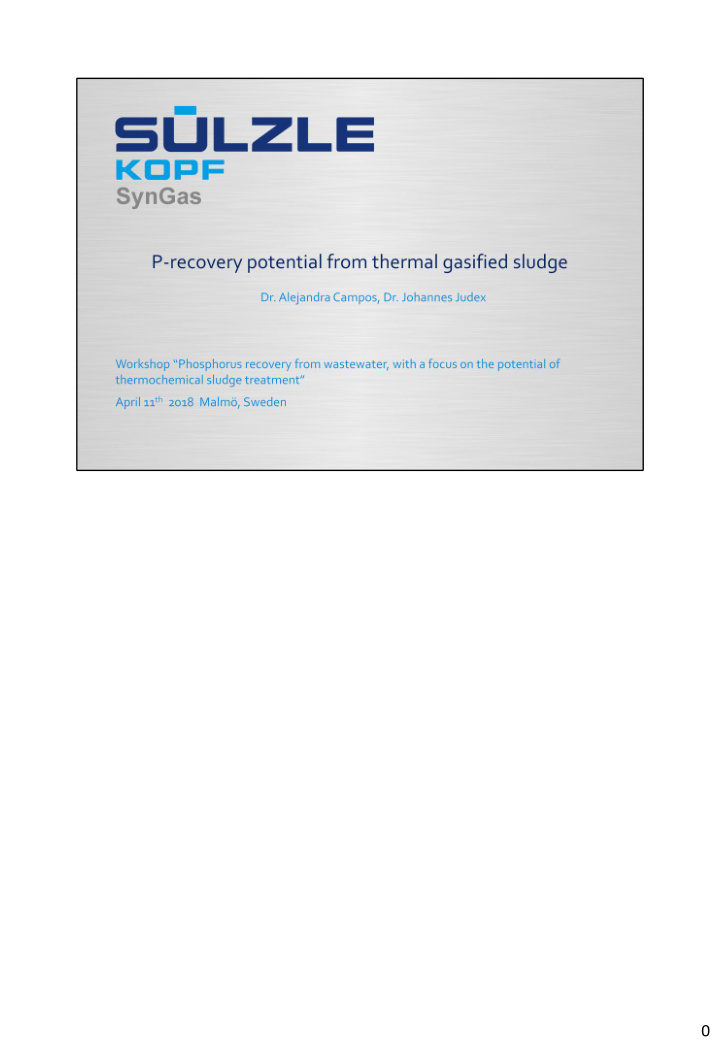



0
1
• The primary approach of Kopf Syngas is to produce ashes that fullfill the quality requirements to be used directly as fertiliser. • The composition of the ashes depends on the quality of the sewage sludge. Because of this, in some cases the expected quality cannot be achieved without post-treatment. In this case look for the cooperation with partners that offer a suitable technology for the treatment of the ashes. 2
• Drying and gasification of sewage sludge reduces the sewage sludge volume considerable. • Processes for P extraction from ashes produce residues. These residues (for instance wet ashes after P leaching) have to be disposed at high costs 3
There are three alternatives for the P recovery from sewage sludge: Alternative A: P recovery only from the liquid fraction of sewage sludge • Disadvantage: Only a small part of P is dissolved in the liquid fraction. It is reported that some technologies have a P recovery of only about 10% . • To increase the P solubility to max. 50% some processes include an acidication step, which results in more operational costs. • The solid fraction have still to be treated and the residues disposed • The advantage of this approach is that the P salts recovered (mainly struvite) have a high plant availability Alternative B: P recovery from ashes • Because most of P is in the solid fraction more than 80% can be recovered as ashes • There is no residues to be disposed because the complete ashes are used as fertiliser • The plant availability of the ashes is medium, comparable to phosphate rock 4
Alternative C: P-extraction of the sewage sludge ashes • This is an alternative in case the the ashes cannot be directly used as fertiliser (for example due to poor quality of sewage sluge with high heavy metals concentration) • P can be extracted as phosphoric acid or other fertiliser products • Disadvantage: Residues to be disposed are produced 5
• The main important parameters for the determination of the ash quality as fertiliser are: Nutrient content, pollutant content and plant availability. 6
• The P content of the ashes is high enough to be used as fertilizer according to the German fertiliser regulation • As expected from this type of material the water soluble P content was low. However, this does not mean that the ashes do not have a fertilising effect in plants. This was proved by the plant tests 7
• The heavy metal concentration in the two ashes was below the threshold of the German Fertiliser regulation • The only exception was the nickel concentration in Ash-Ba sample. However, this high value was not found in other ash samples from the WWTP Balingen. • The approach in this case is to monitor the concentration over time (several weeks) to determine if the nickel concentration consistently exceed the threshold. If this occurs, the ashes will need a post treatment before they can be used as fertilisers. 8
• Aim of this analysis: to determine the phosphorus mineral phases in the ashes after thermal treatment (gasification and combustion) • Future work: to determine the correlation between the thermal process parameteres (e.g. temperature, oxygen content) and the mineral P phases formation and the relation with the P solubility and plant availability 9
• The plant growth test was carried out by the Institute of Crop Science of the Unviersity of Hohenheim. 10
• The performance of the gasification ashes in comparison with phosphate rock was very positive • The higher yield was obtained with calcium phosphate but this was expected because it is a complete water soluble fertiliser. Respect to this, we find that is not adequate to compare one-to-one the performance of fertiliser products from secondary materials (such as ashes) with synthetic soluble products. 11
• The long term P solubility of the P fertilisers in soil was tested with a P CAL extraction method. This is a standard method for soil analysis. • A sample of the soil-fertiliser mixture was dissolved in a calcium-acetate- lactate solution and the dissolved phosphorus in the liquid was measured. • The P CAL concentration of the calcium phosphate sample clearly decresed with time. This can be explained by the sorption reactions that take place in soil, which immobilised the phosphate ions. • The P CAL concentration of the other samples (ashes and rock phosphate) was constant with time. • Conclusion: The gasification ashes can be used as long-term P reservoirs. In this case the P solubility can be comparable with calcium phosphate. 12
13
14
Recommend
More recommend